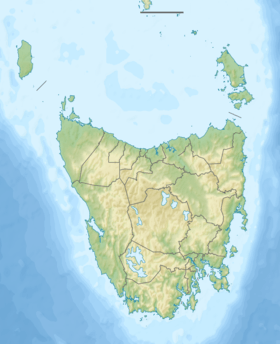Queen River, Tasmania
| Queen | |
| River | |
| | |
| Country | Australia |
|---|---|
| State | Tasmania |
| Region | West Coast |
| City | Queenstown |
| Source | Mount Lyell, West Coast Range |
| - location | Gormanston |
| - coordinates | 42°0′56″S 145°34′46″E / 42.01556°S 145.57944°E |
| Source confluence | West Queen River and East Queen River |
| - location | Queenstown |
| - elevation | 164 m (538 ft) |
| - coordinates | 42°3′47″S 145°33′30″E / 42.06306°S 145.55833°E |
| Mouth | King River |
| - elevation | 60 m (197 ft) |
| - coordinates | 42°09′23″S 145°31′42″E / 42.15639°S 145.52833°ECoordinates: 42°09′23″S 145°31′42″E / 42.15639°S 145.52833°E |
| Length | 13 km (8 mi) |
| [1] | |
The Queen River, part of the King River catchment, is a minor perennial river located in the West Coast region of Tasmania, Australia.
Course and features
The Queen River rises below Gormanston, sourced by runoff from the West Coast Range and in particular the peaks of Mount Lyell and Mount Owen. The two branches of the river, West Queen River and East Queen River, merge north of Queenstown and flow through the city and continue south, joined by one minor tributary before reaching its confluence with the King River, to the west of .
The river valley is low-lying and narrow, and the subsequent fogs are notable in their effect, some created by smelter fumes in earlier years [2][3][4]
In April 1906, a significant flooding occurred in Queenstown and the southern part of the town due to the river overflowing [5][6] Subsequent recorded floods include in 1922,[7] 1937 [8] and 1954 [9]
Tailings
For over 80 years the main carrier of Mount Lyell Mining and Railway Company mining residue, and the local sewage. It is estimated that 100 million tonnes (98,000,000 long tons) of tailings were disposed of into the Queen River. This in turn flowed into the lower part of the King River, and then into a delta at the mouth of the river where it met Macquarie Harbour.[10][11] Following the Mount Lyell Remediation and Research and Demonstration Program construction of tailings dams, and general reduction of waste into this river, the river flow is now rusty in colour rather than silvery grey as it was previously.
The river passes under and adjacent to the revitalised railway now known as the West Coast Wilderness Railway. South of Queenstown on the edge of the river is the early settlement of Lynchford where a gold mine and other mining activity supported a small community in the early days of the railway.[12]
See also
References
- ↑ "Map of Queen River, TAS". Bonzle Digital Atlas of Australia. 2015. Retrieved 30 June 2015.
- ↑ "FOG AT QUEENSTOWN.". Launceston Examiner (Tas. : 1842 - 1899). Tas.: National Library of Australia. 28 June 1899. p. 6. Retrieved 19 June 2015.
- ↑ "A DENSE FOG.". Examiner (Launceston, Tas. : 1900 - 1954). Launceston, Tas.: National Library of Australia. 7 July 1905. p. 6 Edition: DAILY. Retrieved 19 June 2015.
- ↑ "QUEENSTOWN.". Zeehan and Dundas Herald (Tas. : 1890 - 1922). Tas.: National Library of Australia. 22 June 1914. p. 4. Retrieved 19 June 2015.
- ↑ "HEAVY FLOODS IN TASMANIA.". The Register (Adelaide, SA : 1901 - 1929). Adelaide, SA: National Library of Australia. 19 April 1906. p. 5. Retrieved 19 June 2015.
- ↑ "FLOODS IN TASMANIA.". The Argus (Melbourne) (18,644). Victoria, Australia. 19 April 1906. p. 5. Retrieved 6 November 2016 – via National Library of Australia.
- ↑ "QUEEN RIVER.". The Mercury. CXVIII, (17,294). Tasmania, Australia. 10 March 1923. p. 7. Retrieved 6 November 2016 – via National Library of Australia.
- ↑ "QUEENSTOWN COUNCIL.". The Advocate (Australia). Tasmania, Australia. 3 April 1937. p. 8. Retrieved 6 November 2016 – via National Library of Australia.
- ↑ "CLOSE WATCH ON RAIL BRIDGES". The Examiner (Tasmania). CXIII, (45). Tasmania, Australia. 4 May 1954. p. 3. Retrieved 6 November 2016 – via National Library of Australia.
- ↑ Davies, P.; Mitchell, N.; Barmuta, L. (1996). The impact of historical mining operations at Mount Lyell on the water quality and biological health of the King and Queen River catchments, western Tasmania. Mount Lyell Remediation Research and Demonstration Program. Canberra: Supervising Scientist Report 118, Supervising Scientist. ISBN 0-642-24317-4.
- ↑ McQuade, C. V.; Johnston, J. F.; Innes, S. M. Review of historical literature and data on the sources and quality of effluent from the Mount Lyell lease site. Mount Lyell Remediation Research and Demonstration Program. Canberra: Supervising Scientist Report 104, Supervising Scientist. ISBN 0-642-24303-4.
- ↑ Rae, Lou (2001). The Abt Railway and Railways of the Lyell region. Sandy Bay: Lou Rae. ISBN 0-9592098-7-5.
Sources
- Blainey, Geoffrey (2000). The Peaks of Lyell (6th ed.). Hobart: St. David's Park Publishing. ISBN 0-7246-2265-9.
- Whitham, Charles (2003). Western Tasmania - A land of riches and beauty (Reprint 2003 ed.). Queenstown: Municipality of Queenstown.
